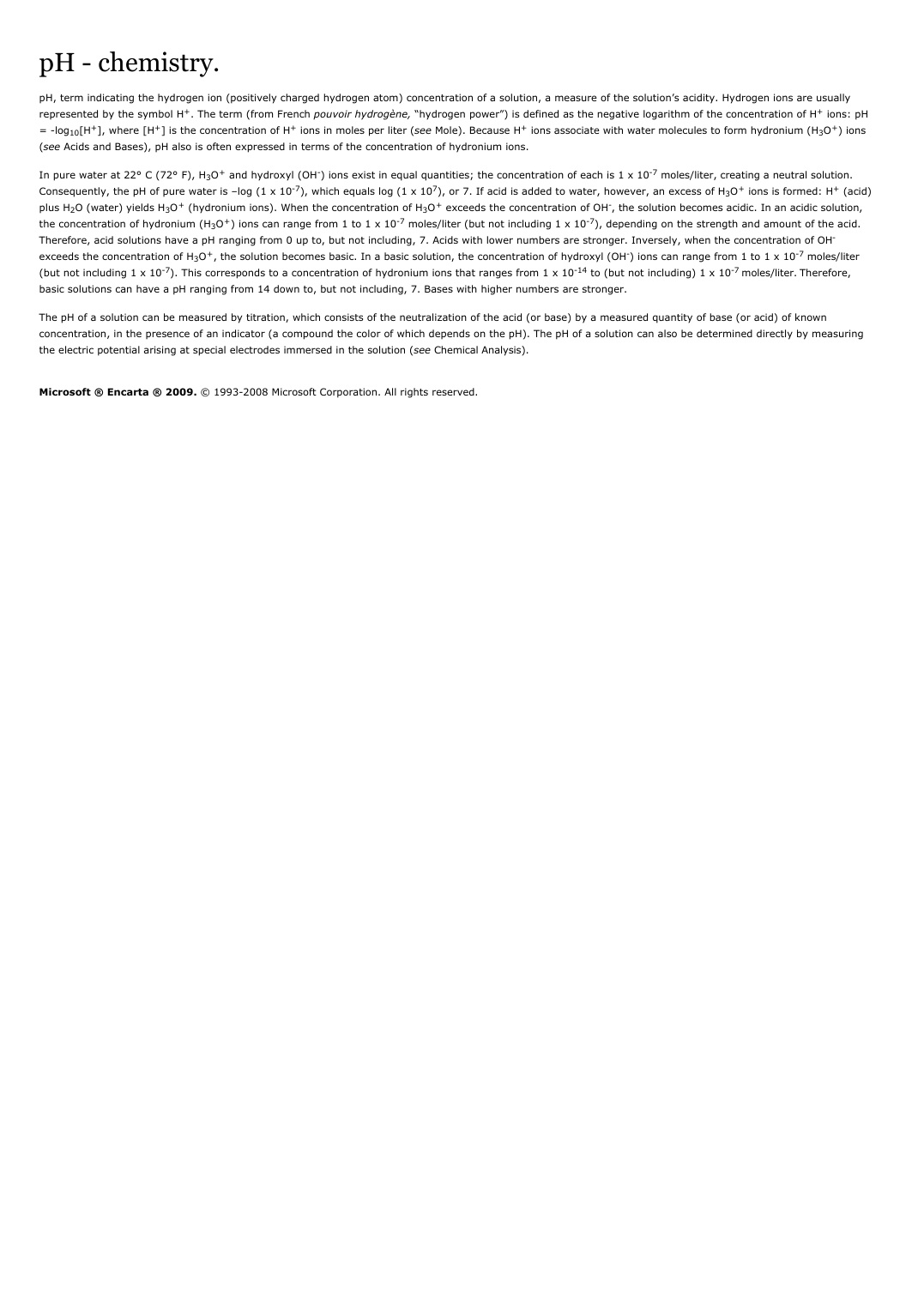pH - chemistry.
Publié le 06/12/2021

Extrait du document
Ci-dessous un extrait traitant le sujet : pH - chemistry.. Ce document contient 418 mots. Pour le télécharger en entier, envoyez-nous un de vos documents grâce à notre système d’échange gratuit de ressources numériques ou achetez-le pour la modique somme d’un euro symbolique. Cette aide totalement rédigée en format pdf sera utile aux lycéens ou étudiants ayant un devoir à réaliser ou une leçon à approfondir en : Echange
pH - chemistry.
pH, term indicating the hydrogen ion (positively charged hydrogen atom) concentration of a solution, a measure of the solution's acidity. Hydrogen ions are usually
represented by the symbol H+ . The term (from French pouvoir hydrogène, "hydrogen power") is defined as the negative logarithm of the concentration of H+ ions: pH
= -log10[H+ ], where [H+ ] is the concentration of H+ ions in moles per liter (see Mole). Because H+ ions associate with water molecules to form hydronium (H3O + ) ions
(see Acids and Bases), pH also is often expressed in terms of the concentration of hydronium ions.
In pure water at 22° C (72° F), H3O + and hydroxyl (OH-) ions exist in equal quantities; the concentration of each is 1 x 10-7 moles/liter, creating a neutral solution.
Consequently, the pH of pure water is -log (1 x 10-7), which equals log (1 x 107), or 7. If acid is added to water, however, an excess of H3O + ions is formed: H+ (acid)
plus H2O (water) yields H3O + (hydronium ions). When the concentration of H3O + exceeds the concentration of OH-, the solution becomes acidic. In an acidic solution,
the concentration of hydronium (H3O + ) ions can range from 1 to 1 x 10-7 moles/liter (but not including 1 x 10-7), depending on the strength and amount of the acid.
Therefore, acid solutions have a pH ranging from 0 up to, but not including, 7. Acids with lower numbers are stronger. Inversely, when the concentration of OHexceeds the concentration of H3O + , the solution becomes basic. In a basic solution, the concentration of hydroxyl (OH-) ions can range from 1 to 1 x 10-7 moles/liter
(but not including 1 x 10-7). This corresponds to a concentration of hydronium ions that ranges from 1 x 10-14 to (but not including) 1 x 10-7 moles/liter. Therefore,
basic solutions can have a pH ranging from 14 down to, but not including, 7. Bases with higher numbers are stronger.
The pH of a solution can be measured by titration, which consists of the neutralization of the acid (or base) by a measured quantity of base (or acid) of known
concentration, in the presence of an indicator (a compound the color of which depends on the pH). The pH of a solution can also be determined directly by measuring
the electric potential arising at special electrodes immersed in the solution (see Chemical Analysis).
Microsoft ® Encarta ® 2009. © 1993-2008 Microsoft Corporation. All rights reserved.
pH - chemistry.
pH, term indicating the hydrogen ion (positively charged hydrogen atom) concentration of a solution, a measure of the solution's acidity. Hydrogen ions are usually
represented by the symbol H+ . The term (from French pouvoir hydrogène, "hydrogen power") is defined as the negative logarithm of the concentration of H+ ions: pH
= -log10[H+ ], where [H+ ] is the concentration of H+ ions in moles per liter (see Mole). Because H+ ions associate with water molecules to form hydronium (H3O + ) ions
(see Acids and Bases), pH also is often expressed in terms of the concentration of hydronium ions.
In pure water at 22° C (72° F), H3O + and hydroxyl (OH-) ions exist in equal quantities; the concentration of each is 1 x 10-7 moles/liter, creating a neutral solution.
Consequently, the pH of pure water is -log (1 x 10-7), which equals log (1 x 107), or 7. If acid is added to water, however, an excess of H3O + ions is formed: H+ (acid)
plus H2O (water) yields H3O + (hydronium ions). When the concentration of H3O + exceeds the concentration of OH-, the solution becomes acidic. In an acidic solution,
the concentration of hydronium (H3O + ) ions can range from 1 to 1 x 10-7 moles/liter (but not including 1 x 10-7), depending on the strength and amount of the acid.
Therefore, acid solutions have a pH ranging from 0 up to, but not including, 7. Acids with lower numbers are stronger. Inversely, when the concentration of OHexceeds the concentration of H3O + , the solution becomes basic. In a basic solution, the concentration of hydroxyl (OH-) ions can range from 1 to 1 x 10-7 moles/liter
(but not including 1 x 10-7). This corresponds to a concentration of hydronium ions that ranges from 1 x 10-14 to (but not including) 1 x 10-7 moles/liter. Therefore,
basic solutions can have a pH ranging from 14 down to, but not including, 7. Bases with higher numbers are stronger.
The pH of a solution can be measured by titration, which consists of the neutralization of the acid (or base) by a measured quantity of base (or acid) of known
concentration, in the presence of an indicator (a compound the color of which depends on the pH). The pH of a solution can also be determined directly by measuring
the electric potential arising at special electrodes immersed in the solution (see Chemical Analysis).
Microsoft ® Encarta ® 2009. © 1993-2008 Microsoft Corporation. All rights reserved.
↓↓↓ APERÇU DU DOCUMENT ↓↓↓
Liens utiles
- « Life is a self-replicating, evoluing system based on organic chemistry » Qu’est ce qui est vivant ?
- Carbon - chemistry.


